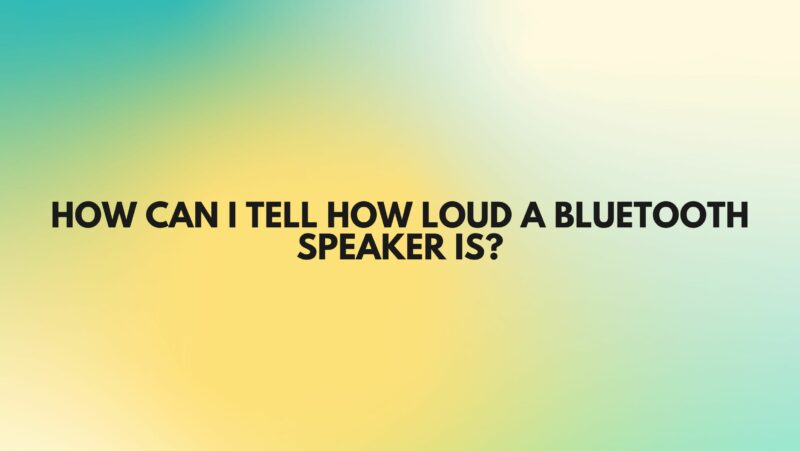Bluetooth speakers come in various shapes, sizes, and specifications, making it essential to understand how to measure their loudness accurately. While manufacturers provide specifications like wattage and decibel ratings, these numbers may not always translate directly to the perceived volume. In this comprehensive article, we’ll explore how to tell how loud a Bluetooth speaker is and consider factors beyond the technical specifications that influence perceived loudness.
1. Understand the Technical Specifications
Most Bluetooth speakers come with specifications that provide some insight into their potential loudness:
- Wattage (W): The wattage rating indicates the power output of the speaker. Generally, higher wattage speakers can produce more volume. However, wattage alone doesn’t tell the whole story.
- Decibel Rating (dB): Decibels measure sound intensity or volume. A higher dB rating typically suggests a louder speaker. However, this rating can be influenced by other factors, such as the speaker’s efficiency and design.
2. Consider the Speaker’s Efficiency
Efficiency, often expressed as sensitivity, plays a significant role in how loud a speaker can get with a given amount of power. Sensitivity is measured in decibels (dB) and represents the speaker’s output level when driven by one watt of power at a distance of one meter. A higher sensitivity rating indicates greater efficiency and potential for higher volume.
3. Look at the Driver Size
The size of a speaker’s driver, typically measured in inches, can impact its ability to produce loud and deep bass tones. Larger drivers tend to move more air and produce more significant low-frequency sound, which contributes to the overall loudness.
4. Assess the Design and Enclosure
The design and enclosure of a Bluetooth speaker can affect its perceived loudness:
- Ported vs. Sealed: Ported or vented enclosures can enhance bass response, making the speaker sound louder and fuller. Sealed enclosures are generally more compact but may have less pronounced bass.
- Sound Enhancement Features: Some Bluetooth speakers incorporate technologies like passive radiators or bass-boosting chambers to improve low-frequency performance and overall volume.
5. Consider Battery-Powered Limitations
Battery-powered Bluetooth speakers may have limitations when it comes to loudness. The speaker’s maximum volume may be limited by the battery’s capacity and the speaker’s power efficiency. Keep in mind that as you approach the speaker’s maximum volume, battery life may decrease faster.
6. Read User Reviews and Conduct Hands-On Testing
User reviews and hands-on testing can provide valuable insights into a Bluetooth speaker’s loudness. Real-world experiences from users can help you gauge how well a speaker performs in different situations, including outdoor environments or large rooms.
7. Pay Attention to Frequency Response
A Bluetooth speaker’s frequency response, typically provided in Hertz (Hz), indicates the range of frequencies it can reproduce. While a wide frequency response can contribute to the perceived loudness, it’s important to ensure that the speaker produces clear and balanced sound across the entire spectrum.
8. Listen to It in Person
Whenever possible, listen to the Bluetooth speaker in person before making a purchase. Personal perception of loudness can vary, and what sounds loud to one person may not be the same for another. Trust your ears and choose a speaker that suits your preferences.
Conclusion
Measuring the loudness of a Bluetooth speaker involves considering technical specifications, such as wattage and sensitivity, as well as factors like driver size, design, and battery limitations. However, perceived loudness is subjective and can vary from person to person. To determine how loud a Bluetooth speaker truly is, it’s crucial to read user reviews, conduct hands-on testing, and, most importantly, trust your own ears. Ultimately, the best Bluetooth speaker is one that provides the volume and sound quality that align with your specific needs and preferences, whether you’re using it for casual listening, parties, or outdoor adventures.

